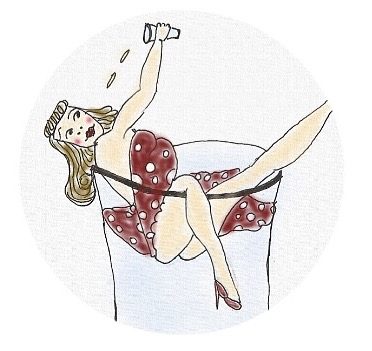(Note: This is a modified version of a piece I wrote for the Stormcloud Brewing Co. mug club members.)
To quote the Oxford Companion to Beer, “Belgium is to beer what Cuba is to cigars and France is to wine.”¹ On that note, I wanted to share with you some information about two traditional Belgian-inspired brews – the Dubbel and the Tripel.

The Belgian monastic brewing tradition started long ago, stemming as far back as the Middle Ages. Many monasteries followed the Rule of St. Benedict of 530 A.D., which told monks how to live a spiritual life and run a monastery. One of the Benedictine values required that monasteries be self-sufficient. This led monks to create wares they could sell – some made bread, some made cheese, some sold eggs, and some made beer!²
The beer of these early monasteries tasted quite different than the modern Belgian beers we know and love³ – and this is largely because of the destruction many of them faced throughout history. Nearly all the monasteries in Belgium were closed or destroyed during the French Revolution in the 1790s. Many were rebuilt, but were once again demolished during World War I. After rebuilding following the war, beer styles such as the Dubbel and Tripel began to emerge. These styles helped return monastery breweries to prominence, but most had to rebuild again after World War II.² One thing that’s certain, the Belgian brewing tradition is resilient!
The Dubbel and Tripel are styles that emerged from what is known as the Trappist tradition. Currently, there are only seven breweries in the world that can legally call their beer Trappist – meaning they are brewed on monastery grounds under the supervision of monks.¹ You may also hear the term Abbey beer, which means while not Trappist, it is brewed in association with an actually monastery.² Because of these specifications, you won’t hear secular breweries calling themselves Trappist or Abbey, even when they make Dubbels or Tripels. Out of respect for this tradition, you’ll often hear these style of beers brewed in America called “Belgian-inspired” or “Belgian-style.”

Discussing the Dubbel and Tripel may lead you to wondering, is there such thing as a Singel? What about a Quadrupel? And what do the names mean?
Yes, there is such thing as a Belgian Singel, but “they remain an elusive beast that rarely leaves the walls of the few monasteries where it’s made.”⁴ As far as Quadrupels go, you may know them under a more familiar name – the Belgian Dark Strong Ale (like Stormcloud’s The Farthest Shore.) Quadrupels and Dark Strongs are pretty universally accepted as synonymous names for the same style.²
As far as these numerical names go, it’s not as simple as one may think – historians can’t seem to agree on where the names come from. Not only that, but there isn’t an exact mathematical relationship between the styles.⁴ Generally, but not always, the alcohol content goes up with each style. They do not double or triple in alcohol content as the names might imply, but instead the average alcohol content goes up by about 1.5-2.0% ABV.

Dubbels are described by the Beer Judge Certification Program 2015 Style Guidelines as “A deep reddish-copper, moderately strong, malty complex Trappist ale with rich malty flavors, dark or dried fruit esters, and light alcohol blended together in a malty presentation that still finishes fairly dry.”⁵ It lists the ABV being somewhere between 6-7.6% and the IBUs being between 15-25 with a low perceived bitterness. Dubbel’s color can range between light amber to dark amber.²
In Dubbels you’ll often find the flavors of caramel, brown sugar, dark rum, raison, plum, or dark cherry.² The Brewers Association recommends pairing this beer style with apple-smoked saysages, washed-rind cheeses, and milk chocolate.⁶ Trust me, I know our Dubbel (B., Sirius) is an excellent food beer – it goes with just about everything on our menu!

Tripels are described by the Beer Judge Certification Program 2015 Style Guidelines as “A pale, somewhat spicy, dry, strong Trappist ale with a pleasant rounded malt flavor and firm bitterness. Quite aromatic, with spicy, fruity, and light alcohol notes combining with the supportive clean malt character to produce a surprisingly drinkable beverage considering the high alcohol level.”⁵ It lists the ABV being between 7.5-9.5% and the IBUs between 20-40 with moderate perceived bitterness. Tripel’s tend to be light gold to gold in color.² I always remember that Dubbels are darker than Tripels through alliteration.
In Tripels, you’ll often find esters that produce flavors such as orange, lemon, apricot, peach, pear, or banana.² A few food pairing suggestion include roasted turkey, triple creme cheese, and caramelized banana creme brûlée.⁶
I hope this blog post taught you a little something you didn’t know about two traditional Belgian-inspired brews. Now all you need is to order a B., Sirius Dubbel or 228 Tripel to go! Cheers!

References for this blog post:
¹Oliver, Garrett, editor. The Oxford Companion to Beer. Oxford University Press, 2012, pp. 1-3.
²De Baets, Yvan, editor. Belgian Beer Styles Course. Cicerone Certification Program, 2020, pp. 67-73. Road to Cicerone®.
³Mulder, Roel. “The Original Belgium Abbey Beers.” Zymurgy, Mar. 2020, pp. 42-43.
⁴Reis, Mike. “A Beginner’s Guide to Belgian Beer Styles.” Serious Eats, edited by Niki Achitoff-Gray, Serious Eats Inc., 4 Mar. 2014, drinks.seriouseats.com/2014/03/guide-to-belgian-beer-styles-what-is-dubbel-quad-saison-wit-lambic-gueuze.html.
⁵BJCP Beer Style Guidelines. 2015 ed., Beer Judge Certification Program, 2015, pp. 52-53.
⁶Baker, Jess, et al. The Guide to Craft Beer. Brewers Publications, 2019, pp. 65-70.
